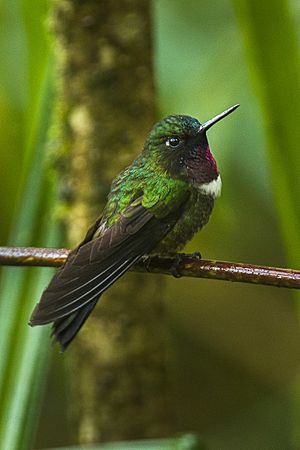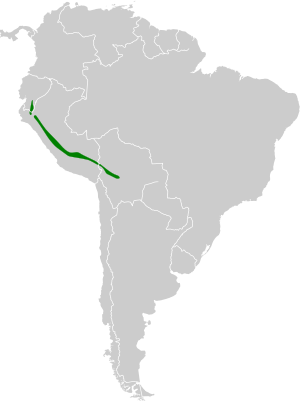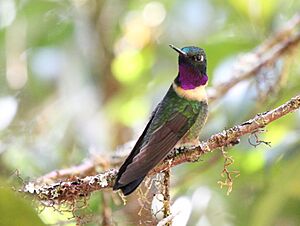Amethyst-throated sunangel facts for kids
Quick facts for kids Amethyst-throated sunangel |
|
|---|---|
 |
|
| Conservation status | |
| Scientific classification | |
| Genus: |
Heliangelus
|
| Species: |
amethysticollis
|
 |
|
| Synonyms | |
|
|
The amethyst-throated sunangel (Heliangelus amethysticollis) is a beautiful type of hummingbird. It belongs to a group of hummingbirds called "coquettes." You can find this small bird living in the countries of Bolivia, Ecuador, and Peru in South America.
Contents
Understanding the Amethyst-throated Sunangel
Scientists sometimes have different ideas about how to group animals. This is also true for the amethyst-throated sunangel.
Most groups, like the International Ornithological Committee (IOC), say there are four main types, or subspecies, of this bird:
- H. a. laticlavius
- H. a. decolor
- H. a. apurimacensis
- H. a. amethysticollis
However, another group, the South American Classification Committee (SACC), thinks there are three more types. These other types are often seen as completely different species by other scientists.
What Does the Sunangel Look Like?
The amethyst-throated sunangel is a small bird. It is about 10 cm (4 inches) long. It weighs between 3.8 and 7.7 grams (0.13 to 0.27 ounces). That's about as much as a few paper clips!
This hummingbird has a straight, short, black beak. The male bird has shiny dark green feathers on its back. It has a bright green patch of feathers just above its beak. Its throat and upper chest have a special patch of feathers called a gorget. This gorget is a beautiful rosy amethyst color.
Below this purple patch, there's a narrow black line. Then, there's a wider cinnamon-colored band. The lower chest is sparkly green. The rest of its belly is a light buff color with green spots. The middle tail feathers are bronze-green, and the outer ones are blue-black.
Female sunangels look a bit different. They have a rusty-colored throat with small black spots. Young birds look similar to the females.
Different types of the sunangel have slightly different colors:
- H. a. laticlavius has a reddish-purple gorget and a whitish chest band.
- H. a. decolor has a deeper violet gorget and a whiter chest band.
- H. a. apurimacensis has a turquoise-green patch on its forehead and a pale buff belly.
Where Do Amethyst-throated Sunangels Live?
These four types of amethyst-throated sunangels live in different areas:
- H. a. laticlavius lives in the Andes mountains of southern Ecuador. It also lives in northern Peru.
- H. a. decolor is found on the eastern side of the Andes in central Peru.
- H. a. apurimacensis lives in the valleys of the Apurímac River and upper Urubamba River in southeastern Peru.
- H. a. amethysticollis lives on the eastern side of the Andes from southern Peru into northwestern Bolivia.
These birds like to live in wet and humid mountain forests. This includes cloudforests, which are often covered in clouds. They prefer to stay inside the dense forest. However, you might also see them at the edges of forests or in open, bushy areas. They usually live at heights between 1,800 and 3,200 meters (5,900 to 10,500 feet) above sea level. Sometimes, they are found even higher, up to 3,700 meters (12,100 feet) in Peru.
How Do Sunangels Behave?
Staying in One Place
The amethyst-throated sunangel does not migrate. It stays in the same area all year round. Scientists call this "sedentary."
What Do They Eat?
This hummingbird mainly eats nectar from flowers. Nectar is a sweet liquid that gives them energy. But they also eat a lot of insects!
They like to defend areas that have many flowers. Since their beak is short, they mostly feed from flowers with shallow shapes. They usually feed up to 6 meters (20 feet) high. They always stay close to trees or bushes for cover. They catch insects by flying out from a perch, grabbing the insect, and returning. This is called "hawking."
How Do They Raise Their Young?
Amethyst-throated sunangels build nests in Peru during February and March. They make their nests from fine plant fibers, moss, and lichens. They attach the nest to a piece of moss hanging from a branch.
They usually place the nest about 1.5 meters (5 feet) above the ground. They also make sure it's under a leaf or a clump of moss. This helps protect the nest from bad weather. The female bird lays two eggs. She is the one who sits on the eggs to keep them warm. Females start breeding when they are two years old. Scientists don't know exactly how long the eggs take to hatch or how long it takes for the young birds to leave the nest.
What Do They Sound Like?
The call of the amethyst-throated sunangel is a short, buzzing, dry trill. They repeat this sound every now and then.
Is the Sunangel in Danger?
The IUCN (International Union for Conservation of Nature) has looked at the amethyst-throated sunangel. They have decided that it is a species of "Least Concern." This means it is not currently in danger of disappearing.
Scientists don't know the exact number of these birds. However, they believe the population is stable. This bird is quite common in many places. It is also found in several protected areas, which helps keep it safe.
See also
 In Spanish: Heliangelus amethysticollis para niños
In Spanish: Heliangelus amethysticollis para niños



